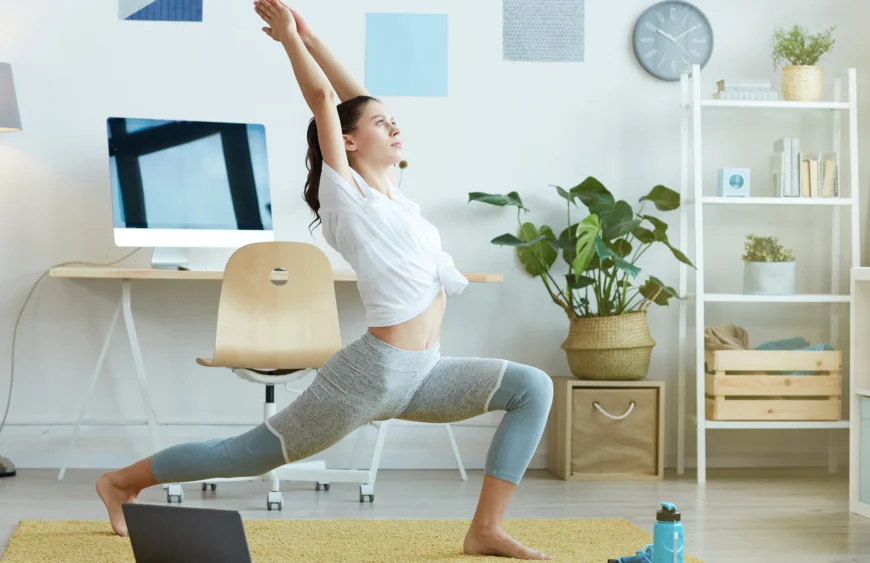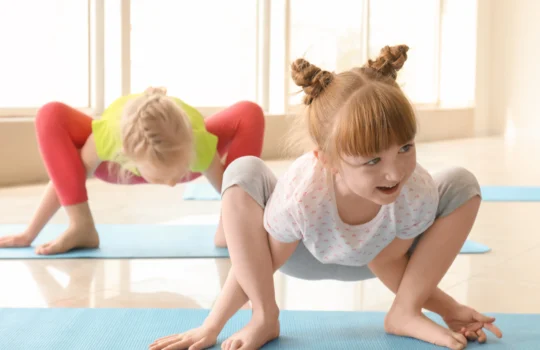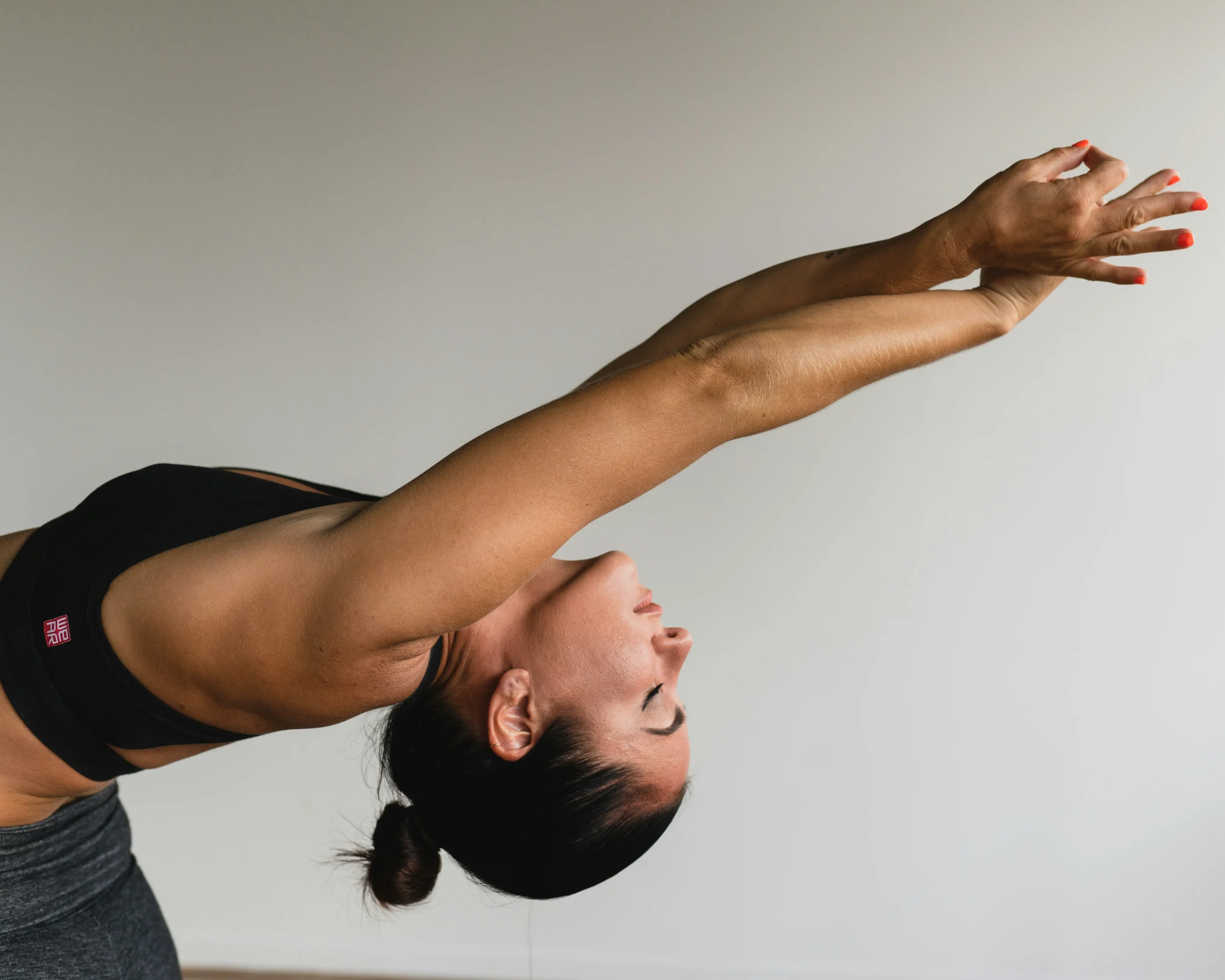If you’re looking to take your yoga workouts to the next level, you’ve come to the right place. Whether you’re a seasoned yogi or just starting out, these expert tips are going to revolutionize your practice.
Get ready to unlock the secrets that will maximize your yoga workout results and leave you feeling stronger, more flexible, and zen-tastic. Ready to dive in? Let’s unroll those mats and get started with the ultimate guide to yoga workout secrets! 🧘♀️✨
Table of Contents
Tip 1: Mastering Breathing Techniques

Alright, let’s talk about breathing – because, believe it or not, how you breathe can make or break your yoga workout! 🌬️ Proper breathing techniques are the foundation of a successful yoga practice. They help you stay focused, deepen your poses, and even keep your energy levels up. Ready to become a breathing pro? Here’s how:
Importance of Breath Control in Yoga
Breathing isn’t just about staying alive (though, yes, it’s crucial for that too). In yoga, breath control, or pranayama, is the secret sauce that connects your mind and body. It helps you move with grace, find your balance, and stay centered. Plus, it can transform your practice from “meh” to “amazing.”
Different Breathing Techniques
There are a few superstar breathing techniques you need to know:
- Ujjayi Breath: Also known as the “Ocean Breath,” this technique involves slightly constricting the back of your throat as you inhale and exhale through your nose. It creates a soothing, wave-like sound and helps regulate your breath during those challenging poses.
- Nadi Shodhana: This alternate nostril breathing is a game-changer for calming your mind and balancing your energy. Simply close one nostril, inhale through the other, then switch and exhale. Repeat this cycle to find your inner zen.
- Belly Breathing: Also known as diaphragmatic breathing, this technique involves expanding your belly as you inhale and contracting it as you exhale. It’s perfect for reducing stress and increasing oxygen flow.
How to Practice Proper Breathing
To nail these techniques, follow these steps:
- Find a Comfortable Seat: Sit cross-legged on your mat or in a chair with your feet flat on the ground. Keep your spine straight and shoulders relaxed.
- Focus on Your Breath: Close your eyes and take a few deep breaths. Notice how the air flows in and out. Start with simple belly breathing, letting your abdomen rise and fall naturally.
- Incorporate Ujjayi Breath: Begin to constrict the back of your throat slightly. You’ll know you’re doing it right when you hear that ocean-like sound. Use this breath during your yoga poses to stay focused and energized.
- Try Nadi Shodhana: Place your right thumb over your right nostril and inhale deeply through your left nostril. Close your left nostril with your ring finger, release your thumb, and exhale through your right nostril. Continue alternating for a few minutes.
Mastering these breathing techniques will elevate your yoga workout practice and help you find a deeper connection with yourself. So, take a deep breath and get ready to conquer your yoga mat like a true pro! 🌟🧘♂️
Read more 10 Solid Benefits of Investing in a Quality Meditation Mat.
Tip 2: Ensuring Proper Alignment
Alright, yoga warriors, let’s dive into one of the most critical aspects of your practice: proper alignment. 🧘♀️💪 Whether you’re twisting into a pretzel or simply standing in Mountain Pose, proper alignment ensures you get the most out of each movement while keeping injuries at bay. Ready to align your chakras and your body? Let’s get into it!
Significance of Alignment in Yoga Poses
Think of alignment as the GPS for your body. It guides you through each pose with precision, ensuring you’re hitting all the right spots without straining your muscles or joints. Proper alignment not only maximizes the benefits of your practice but also keeps you safe. Plus, when you’re aligned correctly, you’ll feel more stable, balanced, and in control.
Common Alignment Mistakes to Avoid
Even seasoned yogis can slip up with alignment. Here are some common mistakes to watch out for:
- Rounding the Back in Forward Folds: It’s tempting to reach for your toes by rounding your spine, but keep it straight! Hinge at the hips instead to protect your lower back.
- Dropping Shoulders in Plank Pose: Your shoulders should be over your wrists, and your body should form a straight line from head to heels. Don’t let those shoulders sag!
- Locking Knees in Standing Poses: Keep a slight bend in your knees to avoid hyperextension and maintain muscle engagement.
- Misaligning Hips in Warrior Poses: Ensure your hips are square and facing forward in poses like Warrior I. This helps distribute your weight evenly and enhances stability.
Using Props for Better Alignment
Props are your best friends when it comes to nailing alignment. Here’s how to use them:
- Blocks: Place them under your hands in poses like Triangle or Half Moon to bring the ground closer and keep your spine elongated.
- Straps: Use straps in poses like Seated Forward Bend to maintain a straight spine and avoid overreaching.
- Bolsters: Place a bolster under your back in restorative poses to support your spine and enhance relaxation.
How to Practice Proper Alignment
Let’s put theory into practice with these steps:
- Start with the Basics: Begin with foundational poses like Mountain Pose, Downward Dog, and Warrior I. Focus on aligning each part of your body correctly.
- Use a Mirror or Take a Class: Practicing in front of a mirror or taking a class with a certified instructor can help you identify and correct alignment issues.
- Engage Your Core: A strong core supports proper alignment. Engage your abdominal muscles to stabilize your spine and maintain balance.
- Listen to Your Body: Pain is a red flag. If something feels off, adjust your pose or use a prop to find a comfortable alignment.
- Regularly Check-In: Throughout your practice, pause and check your alignment. Make adjustments as needed to ensure you’re staying on track.
By prioritizing proper alignment, you’ll enhance your yoga workout practice’s effectiveness and safeguard your body from injury. So, align yourself with these tips and watch your yoga game soar! 🚀✨
Read more about physical alignment and its importance from Nielsen Fitness.
Tip 3: Incorporating Dynamic Movements
Get ready to bring some serious energy to your yoga workout practice! 🌟 Dynamic movements are where the magic happens, transforming your sessions from static poses to fluid, energizing workouts.
Incorporating dynamic movements not only keeps things exciting but also enhances your strength, flexibility, and cardiovascular health. Let’s dive into how you can add this dynamic twist to your yoga workout routine!
Benefits of Dynamic Movements in Yoga
Dynamic movements involve transitioning smoothly from one pose to another, creating a flow that keeps your body engaged and your heart pumping. Here’s why they’re awesome:
- Boosted Cardiovascular Health: Continuous movement increases your heart rate, giving you a cardio workout while still reaping all the benefits of yoga.
- Enhanced Strength and Flexibility: Dynamic sequences build muscle strength and improve flexibility by engaging different muscle groups in various ranges of motion.
- Improved Coordination and Balance: Flowing from pose to pose challenges your coordination and balance, sharpening these skills over time.
- Increased Calorie Burn: The increased intensity of dynamic movements helps burn more calories, which is great for weight management and overall fitness.
Examples of Dynamic Yoga Sequences
Ready to add some flow to your practice? Here are a few dynamic yoga workout sequences to get you started:
- Sun Salutations (Surya Namaskar): This classic sequence warms up your body and gets your blood flowing. Flow through poses like Mountain, Forward Fold, Plank, Upward Dog, and Downward Dog in a continuous loop.
- Vinyasa Flow: In Vinyasa yoga, you link breath with movement. A typical sequence might include transitioning from Plank to Chaturanga to Upward Dog, and then to Downward Dog, synchronizing each movement with an inhale or exhale.
- Dynamic Warrior Sequences: Flow between Warrior I, Warrior II, and Reverse Warrior, adding transitions like lunges or side stretches to keep things moving.
- Core Flow: Engage your core with dynamic sequences like Boat Pose to Low Boat, or transitioning between Plank and Side Plank.
How to Incorporate Flow into Your Practice
Now that you know the benefits and some sequences, here’s how to seamlessly incorporate dynamic movements into your routine:
- Start Slow: Begin with slow, controlled movements to ensure proper alignment and prevent injury. Gradually increase the pace as you become more comfortable.
- Link Breath to Movement: Synchronize your breath with your movements. Inhale as you move into one pose, and exhale as you transition to the next. This not only helps with flow but also keeps you centered and focused.
- Mix Static and Dynamic Poses: Balance your practice by combining static holds with dynamic flows. For example, hold Warrior II for a few breaths, then transition smoothly into Side Angle Pose.
- Experiment with Different Styles: Try different yoga styles like Vinyasa, Power Yoga, or Ashtanga, which naturally incorporate dynamic movements. This will keep your practice fresh and challenging.
Dynamic movements can transform your yoga workout practice, making it more invigorating and effective. So, get ready to flow, sweat, and smile as you move with grace and power! 🧘♂️💫
Tip 4: Balancing Strength and Flexibility
Balancing strength and flexibility in your yoga practice is like finding the perfect harmony in a symphony. 🎶 Both elements are essential for a well-rounded practice that not only tones your body but also enhances your range of motion and overall stability. Ready to strike that perfect balance? Let’s explore how you can enhance both strength and flexibility in your yoga workout.
The Need for Both Strength and Flexibility
Why is it important to have both strength and flexibility? Here’s the scoop:
- Injury Prevention: Strong muscles support your joints and protect them from strain, while flexibility helps you move freely without pulling or tearing muscles.
- Improved Performance: Strength enables you to hold poses longer and with better form, while flexibility allows you to move into and out of poses smoothly and gracefully.
- Balanced Body: Focusing on both aspects ensures you don’t become overly tight (from only building strength) or too loose (from only stretching), leading to a more balanced and functional body.
Yoga Poses that Build Strength
Incorporate these power-packed poses into your routine to boost your strength:
- Plank Pose (Phalakasana): Engages your core, arms, and shoulders. Hold for several breaths to build endurance.
- Warrior II (Virabhadrasana II): Strengthens your legs, hips, and core. Keep your front knee bent and arms extended.
- Chair Pose (Utkatasana): A great way to work your thighs, glutes, and core. Sit back as if you’re sitting in an invisible chair.
- Boat Pose (Navasana): Targets your abdominal muscles and hip flexors. Lift your legs and balance on your sit bones.
- Crow Pose (Bakasana): An advanced pose that builds arm and core strength. Balance on your hands with your knees resting on your upper arms.
Yoga Poses that Enhance Flexibility
To improve your flexibility, try these stretches:
- Forward Fold (Uttanasana): Stretches your hamstrings, calves, and lower back. Let your head hang heavy and reach for your toes.
- Pigeon Pose (Eka Pada Rajakapotasana): Opens up your hips and relieves tension in your glutes and lower back.
- Bridge Pose (Setu Bandhasana): Stretches your chest, neck, and spine. Press your feet into the mat and lift your hips.
- Seated Forward Bend (Paschimottanasana): Targets your hamstrings and lower back. Sit with your legs extended and reach for your feet.
- Camel Pose (Ustrasana): A deep backbend that opens your chest, shoulders, and quads. Lean back and reach for your heels.
How to Balance Strength and Flexibility in Your Practice
Here’s how to achieve that perfect blend of strength and flexibility:
- Alternate Focus: Dedicate certain days to strength-building poses and others to flexibility-enhancing stretches. For example, you could focus on strength three days a week and flexibility the other two.
- Combine in One Session: Incorporate both strength and flexibility poses into each session. Start with dynamic movements that build strength and finish with deep stretches to enhance flexibility.
- Use Props: Blocks, straps, and bolsters can help you achieve better alignment and deeper stretches without compromising strength. For instance, use a block in Warrior III to maintain balance while building leg strength.
- Listen to Your Body: Pay attention to what your body needs. If you’re feeling tight, focus more on stretching. If you feel like you need to build muscle, add more strength-focused poses.
- Mindful Transitions: Move mindfully between poses, maintaining engagement in your muscles to build strength while stretching.
Balancing strength and flexibility in your yoga workout practice will help you achieve a well-rounded, healthy body that can move with both power and grace. So, get ready to flex those muscles and stretch into new possibilities! 💪🧘♀️
Tip 5: Utilizing Yoga Props

Props to you for considering yoga props in your practice! 🧘♀️✨ These handy tools can transform your yoga routine by enhancing alignment, providing support, and deepening your stretches. Whether you’re a beginner or a seasoned yogi, incorporating props can make your practice more effective and enjoyable. Let’s explore the wonderful world of yoga props and how to use them to your advantage.
Types of Yoga Props
Yoga props come in various shapes and sizes, each serving a unique purpose. Here are the essential ones you should have in your yoga toolkit:
- Blocks: Typically made of foam, cork, or wood, yoga blocks help bring the floor closer to you, providing support in standing poses and helping with balance.
- Straps: Yoga straps (or belts) assist in maintaining proper alignment and extending your reach in poses where flexibility is limited.
- Bolsters: These firm cushions are great for restorative poses and provide support to help you relax and open up more deeply.
- Blankets: Folded blankets offer extra padding and support, particularly under the knees, hips, or shoulders.
- Wheels: Yoga wheels can help with deepening stretches, improving balance, and providing support in backbends.
Benefits of Using Props
Why should you use props? Here are the top benefits:
- Enhanced Alignment: Props help you achieve proper alignment, which is crucial for preventing injuries and maximizing the effectiveness of each pose.
- Increased Accessibility: Props make challenging poses more accessible, allowing you to gradually build strength and flexibility without overstraining.
- Support and Stability: They provide support and stability, particularly in balancing poses, which helps you maintain poses longer and with better form.
- Deeper Stretches: Props can help you deepen your stretches safely, allowing your body to gradually release tension and improve flexibility.
- Restorative Benefits: In restorative yoga, props enable you to fully relax and release into poses, promoting relaxation and recovery.
How to Integrate Props into Your Practice
Now, let’s talk about how to effectively use these props in your yoga practice:
- Blocks:
- Standing Forward Fold (Uttanasana): Place blocks under your hands if they don’t reach the floor. This helps maintain a straight spine and proper alignment.
- Triangle Pose (Trikonasana): Use a block under your bottom hand to support your balance and deepen the stretch in your hamstrings and side body.
- Straps:
- Seated Forward Bend (Paschimottanasana): Loop a strap around your feet and gently pull to help extend your spine and reach your toes.
- Dancer’s Pose (Natarajasana): Use a strap to hold your lifted foot, helping you maintain balance and proper alignment as you deepen the backbend.
- Bolsters:
- Supported Bridge Pose (Setu Bandhasana): Place a bolster under your lower back for support, allowing you to relax and open your chest and hips.
- Child’s Pose (Balasana): Rest your torso on a bolster to fully relax and release tension in your back and shoulders.
- Blankets:
- Knee Support in Lunges: Place a folded blanket under your back knee to cushion it and prevent discomfort during lunges.
- Shoulder Stand (Sarvangasana): Fold a blanket and place it under your shoulders to support your neck and spine.
- Wheels:
- Heart Opener: Lie back over the yoga wheel to open your chest and shoulders, relieving tension and improving flexibility.
- Deep Backbends: Use the wheel to support your back in poses like Camel Pose (Ustrasana), helping you deepen the stretch safely.
By incorporating these props into your practice, you’ll find that your yoga workout sessions become more supportive, accessible, and transformative. So, grab those blocks, straps, and bolsters, and get ready to elevate your yoga game! 🌟🧘♂️
Read more about Summer’s Most Liked Zen Yoga Accessories and Equipment (For 2024!)
Tip 6: Integrating Meditation and Mindfulness

Ready to take your yoga practice to a deeper level? 🌟 Integrating meditation and mindfulness into your yoga routine can transform not just your practice, but your entire well-being. These powerful tools help you stay present, reduce stress, and enhance your connection with your body and mind. Let’s explore how you can seamlessly blend meditation and mindfulness with your yoga workout for maximum results.
The Role of Meditation in Yoga
Meditation is the art of focusing your mind and eliminating distractions. When combined with yoga workout, it amplifies the mental and emotional benefits, promoting a sense of inner peace and clarity. Here’s why meditation is a game-changer for your yoga practice:
- Enhanced Focus: Meditation trains your mind to stay present, which is crucial for maintaining balance and alignment in your poses.
- Stress Reduction: Regular meditation helps lower stress levels and promotes relaxation, making your yoga practice a sanctuary of calm.
- Improved Self-Awareness: Meditation cultivates a deeper awareness of your body and mind, helping you tune into your needs and limits.
Simple Meditation Techniques for Yogis
Not sure where to start? Here are some easy meditation techniques to integrate into your yoga routine:
- Breath Awareness Meditation: Sit comfortably and focus on your breath. Notice the inhale and exhale, the rise and fall of your chest. If your mind wanders, gently bring it back to your breath. This can be done at the beginning or end of your yoga workout session.
- Body Scan Meditation: Lie down in Savasana (Corpse Pose) and mentally scan your body from head to toe. Notice any areas of tension and consciously relax them. This helps deepen relaxation and release stress.
- Mantra Meditation: Choose a calming word or phrase (like “peace” or “I am calm”) and repeat it silently to yourself. This can help focus your mind and create a sense of tranquility during your practice.
Practicing Mindfulness During Yoga
Mindfulness is all about being fully present in the moment. Here’s how to weave mindfulness into your yoga workout practice:
- Mindful Movement: Pay close attention to how your body feels as you move through each pose. Notice the sensations in your muscles, the alignment of your bones, and the flow of your breath.
- Non-Judgmental Awareness: Practice observing your thoughts and feelings without judgment. If you can’t reach a pose or your mind wanders, acknowledge it without criticism and gently refocus.
- Engage Your Senses: Tune into the sounds, sights, and smells around you during your practice. This can help ground you in the present moment and deepen your experience.
How to Integrate Meditation and Mindfulness into Your Practice
Here’s a step-by-step guide to seamlessly incorporate meditation and mindfulness into your yoga routine:
- Start with a Mindful Warm-Up: Begin your session with a few minutes of seated meditation or breath awareness. This sets a calm, focused tone for your practice.
- Infuse Mindfulness into Your Poses: As you move through your yoga workout sequence, maintain a mindful awareness of your body and breath. Stay present in each pose, noticing the subtleties of alignment and sensation.
- End with Meditation: Conclude your practice with a longer meditation session. Choose a comfortable seated position or lie down in Savasana. Focus on your breath, a mantra, or simply observe your thoughts and sensations.
- Create a Routine: Consistency is key. Set aside specific times for integrating meditation and mindfulness into your practice. Even a few minutes each day can make a significant difference.
- Use Guided Meditations: If you’re new to meditation, guided sessions can be incredibly helpful. There are plenty of apps and online resources available to guide you through mindfulness and meditation practices.
By integrating meditation and mindfulness into your yoga workout practice, you’ll cultivate a deeper sense of peace, awareness, and connection. This holistic approach will not only enhance your yoga workout but also enrich your overall quality of life. So, breathe deep, stay present, and let the tranquility flow. 🌈🧘♂️
Read more about How Yoga Meditation Changed My Life: 5 Inspiring Personal Stories.
Tip 7: Creating a Consistent Routine
One of the keys to reaping the full benefits of yoga is consistency. 🧘♀️✨ Establishing a regular yoga workout routine helps you build strength, increase flexibility, and enhance your overall well-being. Plus, it becomes a cherished part of your day, something you look forward to. Ready to make yoga a consistent and rewarding part of your life? Let’s dive into how you can create and stick to a yoga workout routine that works for you.
Importance of Consistency in Yoga Practice
Why is consistency so crucial? Here are a few reasons:
- Progress and Improvement: Regular practice leads to gradual improvement in your strength, flexibility, and balance. Each session builds on the last, allowing you to progress steadily.
- Habit Formation: Consistency turns yoga into a habit. Once it becomes a regular part of your routine, you’re less likely to skip sessions.
- Mental and Emotional Benefits: Regular yoga workout practice helps manage stress, anxiety, and emotional health. It promotes a sense of calm and mental clarity that accumulates over time.
- Body Awareness: Practicing consistently enhances your awareness of your body’s needs and limitations, helping you avoid injuries and improve your practice safely.
Tips for Building a Sustainable Yoga Routine
Here’s how to create a yoga workout routine that’s sustainable and enjoyable:
- Set Realistic Goals: Start with achievable goals. If you’re new to yoga, aim for 15-20 minutes a day, a few times a week. As you become more comfortable, gradually increase the duration and frequency.
- Choose the Right Time: Find a time of day that works best for you and stick to it. Whether it’s a morning wake-up, a midday break, or an evening wind-down, consistency in timing helps build the habit.
- Create a Dedicated Space: Set up a yoga space at home where you feel comfortable and undistracted. It doesn’t need to be large; a quiet corner with your mat and props is perfect.
- Follow a Plan: Use online classes, apps, or yoga DVDs to guide your practice. Having a plan removes the guesswork and keeps your sessions structured.
- Listen to Your Body: Pay attention to how your body feels each day and adjust your practice accordingly. Some days you might need a gentle flow, while other days you might feel up for a more vigorous session.
- Mix It Up: Keep your routine interesting by varying the styles and intensity of yoga workout. Try Vinyasa, Hatha, Yin, or Power Yoga to keep things fresh and challenging.
- Stay Accountable: Share your goals with a friend or join a yoga community online or in-person. Having someone to check in with can motivate you to stay consistent.
Overcoming Common Obstacles to Consistency
Life can get busy, and sticking to a routine can be challenging. Here’s how to overcome common obstacles:
- Time Constraints: If you’re short on time, remember that even a short session is beneficial. A quick 10-minute stretch or a few sun salutations can make a big difference.
- Lack of Motivation: On days when motivation is low, remind yourself of the benefits of yoga workout and how great you feel after a session. Sometimes, just starting is the hardest part.
- Travel and Schedules: If you’re traveling or have a busy schedule, be flexible with your practice. Use online classes or apps that you can access anywhere, anytime.
- Physical Limitations: If you’re dealing with an injury or physical limitation, modify your practice accordingly. Use props, choose gentler poses, and consult with a yoga instructor for guidance.
Creating a Routine That Works for You
Here’s a sample weekly routine to get you started:
- Monday: 20-minute Morning Stretch (Focus on gentle poses to wake up your body)
- Tuesday: 30-minute Vinyasa Flow (Build strength and flexibility)
- Wednesday: 15-minute Meditation and Yin Yoga (Relax and restore)
- Thursday: 30-minute Power Yoga (Intense session for strength and stamina)
- Friday: 20-minute Gentle Yoga (Ease into the weekend with a relaxing flow)
- Saturday: 45-minute Hatha Yoga (Balanced practice with a mix of poses)
- Sunday: Rest or light stretching (Listen to your body and take a break if needed)
Creating a consistent yoga workout routine tailored to your lifestyle and goals will transform your practice and your well-being. So, roll out your mat, set your intentions, and embrace the journey of regular yoga workout practice. Namaste! 🌟🙏
Tip 8: Listening to Your Body
Your body is the ultimate guide to a safe and effective yoga workout practice. 🧘♀️✨ Learning to listen to your body is crucial for avoiding injuries, enhancing your practice, and truly benefiting from the mind-body connection that yoga offers. Ready to tune into your body’s wisdom? Let’s explore how you can become more attuned to your body’s signals and make your yoga workout practice more personalized and beneficial.
Understanding Your Body’s Limits
Listening to your body starts with understanding its limits and respecting them. Here’s why this is important:
- Prevents Injuries: Pushing your body too hard can lead to strains, sprains, or more serious injuries. Recognizing your limits helps you practice safely.
- Promotes Healing: If you’re recovering from an injury, tuning into your body allows you to modify poses and avoid movements that could exacerbate your condition.
- Enhances Comfort and Enjoyment: Yoga workout should feel good. By respecting your body’s limits, you create a practice that is enjoyable and sustainable.
How to Listen to Your Body
Here are some tips to help you become more mindful of your body’s signals during yoga:
- Notice Sensations: Pay attention to how your body feels in each pose. Notice any tightness, discomfort, or ease. Use these sensations as a guide to adjust your practice.
- Breathe Mindfully: Your breath is a powerful indicator of your body’s state. If you find yourself holding your breath or breathing shallowly, it may be a sign that you need to ease up or take a break.
- Pain vs. Discomfort: Learn to distinguish between discomfort (a signal to back off slightly) and pain (a signal to stop immediately). Discomfort is a natural part of stretching and strengthening, but pain is a warning sign.
- Adjust Poses: Modify poses to suit your body’s needs. Use props, reduce the depth of a pose, or choose an alternative pose that provides similar benefits without strain.
- Take Breaks: It’s okay to rest. If you’re feeling fatigued, take a Child’s Pose or Savasana to recharge. Listen to your energy levels and don’t force yourself to keep going if you’re exhausted.
How to Avoid Overexertion
Avoiding overexertion is key to a sustainable yoga workout practice. Here’s how to ensure you’re not pushing too hard:
- Set Realistic Goals: Aim for gradual progress rather than instant results. Set achievable goals that encourage steady improvement without overexertion.
- Warm Up Properly: Start your practice with a gentle warm-up to prepare your muscles and joints for more intense poses.
- Cool Down: End your session with a cool-down period to relax your muscles and promote recovery.
- Hydrate and Nourish: Keep your body hydrated and nourished. Proper hydration and nutrition support your energy levels and overall performance.
- Rest and Recover: Allow time for rest and recovery between sessions. Your muscles need time to heal and grow stronger.
Adjusting Your Practice Based on Your Body’s Needs
Your body’s needs can change daily based on factors like sleep, stress, and physical activity. Here’s how to adjust your practice accordingly:
- Tune Into Daily Variations: Each day is different. Some days you might feel energetic and ready for a vigorous practice, while other days you might need a gentler session. Listen to these variations and adjust your practice accordingly.
- Modify for Injuries: If you’re dealing with an injury, modify your poses to avoid aggravating it. Focus on poses that support healing and avoid those that cause pain.
- Focus on What Feels Good: Prioritize poses and sequences that feel good to your body. This might mean spending more time in restorative poses or choosing a flow that emphasizes stretching over strength.
- Seek Guidance: If you’re unsure how to adjust your practice, consider seeking guidance from a yoga instructor. They can provide personalized advice based on your needs.
Embracing a Mindful Practice
Listening to your body is all about cultivating mindfulness. Here’s how to embrace a mindful approach to yoga:
- Stay Present: Focus on the present moment during your practice. Pay attention to your breath, body, and mind without distraction.
- Practice Gratitude: Appreciate what your body can do. Celebrate small victories and progress rather than focusing on limitations.
- Be Patient: Progress in yoga takes time. Be patient with yourself and enjoy the journey rather than rushing toward goals.
By listening to your body, you create a yoga workout practice that is safe, effective, and deeply rewarding. So, tune into your body’s wisdom, honor its signals, and let your practice be a true reflection of self-love and awareness. Namaste! 🌟🧘♂️
Common Mistakes to Avoid in Your Yoga Workout
Embarking on a yoga journey is an exciting and rewarding experience, but it’s essential to steer clear of common pitfalls to ensure your practice is safe and effective. 🧘♀️✨ Let’s uncover the most frequent mistakes yogis make and how you can avoid them to maximize the benefits of your yoga workouts.
Overstretching
Mistake: Pushing your body beyond its limits to achieve a deeper stretch.
Why It’s a Problem: Overstretching can lead to muscle strains, ligament injuries, and long-term damage.
Solution: Listen to your body and respect its boundaries. Use props like blocks and straps to aid your stretches safely. Remember, flexibility develops gradually with consistent practice.
Ignoring Pain Signals
Mistake: Continuing to practice despite experiencing pain.
Why It’s a Problem: Pain is a signal that something is wrong. Ignoring it can result in serious injuries.
Solution: Differentiate between discomfort (which can be normal) and sharp, acute pain (which is not). If you feel pain, ease out of the pose immediately and modify or skip it.
Skipping Warm-Up and Cool-Down
Mistake: Jumping straight into intense poses without warming up, and ending the session abruptly without cooling down.
Why It’s a Problem: Without proper warm-up, your muscles are more prone to injury. Skipping cool-down can lead to muscle stiffness and reduced flexibility.
Solution: Always start with a gentle warm-up to prepare your body and end with a cool-down to relax your muscles. Simple stretches and breathing exercises are great for both.
Comparing Yourself to Others
Mistake: Measuring your progress against others, whether in a class or on social media.
Why It’s a Problem: Yoga is a personal journey. Comparing yourself can lead to frustration, low self-esteem, and potential overexertion as you try to match others.
Solution: Focus on your own progress and celebrate your milestones. Everyone’s body is different, and yoga is about personal growth and self-awareness.
Holding Your Breath
Mistake: Forgetting to breathe or holding your breath, especially during challenging poses.
Why It’s a Problem: Breath is crucial for maintaining balance, reducing tension, and ensuring proper oxygen flow to your muscles.
Solution: Practice mindful breathing throughout your session. Synchronize your breath with your movements, inhaling and exhaling deeply and consistently.
Practicing on an Uneven Surface
Mistake: Doing yoga on a surface that isn’t flat or stable.
Why It’s a Problem: Uneven surfaces can affect your balance and alignment, increasing the risk of injury.
Solution: Use a high-quality yoga mat on a flat, non-slip surface. If you’re practicing outdoors, find a level area to set up your mat.
Wearing Inappropriate Clothing
Mistake: Wearing clothes that are too loose, tight, or uncomfortable.
Why It’s a Problem: Inappropriate clothing can restrict your movement or distract you during your practice.
Solution: Choose comfortable, stretchy clothing that allows for a full range of motion. Avoid anything too loose that might get in the way or too tight that might restrict movement.
Neglecting Hydration
Mistake: Not drinking enough water before and after your yoga session.
Why It’s a Problem: Dehydration can lead to fatigue, muscle cramps, and reduced performance.
Solution: Hydrate well before your practice and have water nearby to sip as needed. Post-session, replenish your fluids to aid recovery.
Overdoing It
Mistake: Practicing excessively without giving your body time to rest and recover.
Why It’s a Problem: Overtraining can lead to burnout, injuries, and decreased motivation.
Solution: Balance your practice with adequate rest days. Listen to your body’s signals and incorporate gentle, restorative yoga sessions to complement more intense practices.
Neglecting Proper Alignment
Mistake: Focusing on achieving a pose rather than maintaining proper alignment.
Why It’s a Problem: Poor alignment can cause joint and muscle strain, leading to injuries over time.
Solution: Pay attention to alignment cues and use mirrors or seek feedback from an instructor to ensure correct form. Use props to assist in maintaining alignment.
By avoiding these common mistakes, you can ensure your yoga practice is safe, effective, and enjoyable. Remember, yoga is a journey of self-discovery and growth, so take your time, listen to your body, and embrace each moment on the mat. Namaste! 🌟🙏
The Role of Diet and Hydration in Yoga
Just as important as the poses you practice on the mat, diet and hydration play crucial roles in enhancing your yoga experience and overall well-being. 🧘♀️✨ Proper nutrition and staying hydrated can significantly impact your energy levels, performance, and recovery. Let’s explore how to fuel your body for optimal results in your yoga practice.
Importance of Nutrition for Yoga Practice
Your diet provides the essential nutrients your body needs to perform and recover from yoga workouts. Here’s why nutrition is vital:
- Energy: The right foods supply the energy required for physical activity. Without adequate nutrition, you may feel sluggish and unable to perform at your best.
- Muscle Health: Proteins, vitamins, and minerals are crucial for muscle repair and growth, helping you maintain strength and flexibility.
- Overall Wellness: A balanced diet supports your immune system, digestion, and overall health, allowing you to practice yoga more effectively and consistently.
Pre-Workout Nutrition Tips
Eating the right foods before your yoga session can make a big difference. Here’s what to consider:
- Timing: Eat a light meal or snack 1-2 hours before your practice to avoid feeling heavy or sluggish. This gives your body time to digest.
- Balance: Choose a mix of carbohydrates for energy, protein for muscle support, and healthy fats for sustained energy. Examples include:
- A smoothie with banana, spinach, and protein powder.
- Greek yogurt with berries and a sprinkle of nuts.
- Whole-grain toast with almond butter and a slice of banana.
- Hydration: Start hydrating well before your session. Drink water throughout the day to ensure you’re well-hydrated before you begin.
Post-Workout Nutrition Tips
What you eat after yoga is equally important for recovery and replenishment. Here’s how to refuel:
- Timing: Aim to eat within 30-60 minutes after your session to replenish glycogen stores and kickstart muscle recovery.
- Balance: Focus on a combination of protein and carbohydrates. Examples include:
- A quinoa salad with mixed vegetables and grilled chicken.
- A protein shake with fruit and a scoop of protein powder.
- Hummus with carrot sticks and whole-grain crackers.
- Hydration: Rehydrate by drinking water or an electrolyte-rich drink, especially if you’ve had an intense or sweaty session.
Staying Hydrated for Optimal Performance
Hydration is key to maintaining energy levels and preventing muscle cramps and fatigue. Here’s how to stay properly hydrated:
- Daily Intake: Aim to drink at least 8-10 glasses of water a day. Adjust based on your activity level, climate, and individual needs.
- During Practice: Keep a water bottle nearby and take small sips during your practice to stay hydrated, especially if you’re doing a vigorous or hot yoga session.
- Post-Practice: Drink water immediately after your session to replace fluids lost through sweat. Consider a drink with electrolytes if you’ve had an especially intense workout.
Foods to Enhance Your Yoga Practice
Incorporate these nutrient-rich foods into your diet to support your yoga practice:
- Leafy Greens: Spinach, kale, and other greens are rich in vitamins and minerals that support overall health and muscle function.
- Berries: Packed with antioxidants, berries help reduce inflammation and support recovery.
- Nuts and Seeds: A great source of healthy fats, protein, and fiber, nuts and seeds provide sustained energy and support muscle health.
- Whole Grains: Brown rice, quinoa, and oats provide complex carbohydrates for lasting energy.
- Lean Proteins: Chicken, fish, tofu, and legumes help repair and build muscle tissue.
Avoiding Common Dietary Pitfalls
To get the most out of your yoga practice, be mindful of these common dietary pitfalls:
- Heavy Meals: Avoid heavy, rich meals before practice, as they can lead to discomfort and sluggishness.
- Dehydrating Beverages: Limit caffeine and alcohol, which can dehydrate you and affect your performance.
- Processed Foods: Minimize consumption of processed and high-sugar foods, which can lead to energy crashes and inflammation.
By paying attention to your diet and hydration, you can enhance your yoga practice, improve your performance, and support your overall health. So, fuel up wisely, hydrate well, and enjoy the many benefits that yoga brings to your body and mind. Namaste! 🌟💧
The Importance of Rest and Recovery in Yoga
Rest and recovery are just as vital as the practice itself when it comes to yoga. 🧘♀️✨ Incorporating adequate rest and recovery into your routine ensures that your body has the time it needs to heal, strengthen, and rejuvenate. Let’s dive into why rest and recovery are crucial and how you can integrate them effectively into your yoga practice.
Understanding the Role of Rest in Yoga
Rest is essential for several reasons:
- Muscle Repair and Growth: During yoga, your muscles undergo stress and small tears. Rest periods allow these muscles to repair and grow stronger.
- Preventing Overuse Injuries: Continuous practice without adequate rest can lead to overuse injuries, such as strains and sprains. Rest helps mitigate these risks.
- Mental Rejuvenation: Yoga isn’t just physical; it also involves mental and emotional exertion. Rest helps rejuvenate your mind, reducing stress and enhancing mental clarity.
- Balancing Energy Levels: Regular rest helps maintain balanced energy levels, preventing burnout and keeping you motivated and enthusiastic about your practice.
Techniques for Recovery and Relaxation
Incorporate these techniques to ensure effective recovery and relaxation:
- Restorative Yoga: This gentle form of yoga uses props to support your body in restful poses. It focuses on deep relaxation and recovery.
- Example: Supported Child’s Pose (Balasana) with a bolster under your torso.
- Yoga Nidra: Also known as yogic sleep, this guided meditation practice induces deep relaxation and mental calmness.
- How to Practice: Lie down in Savasana (Corpse Pose) and follow a guided Yoga Nidra session, focusing on breathing and body awareness.
- Gentle Stretching: Light, gentle stretches can help relieve tension and promote flexibility without straining your muscles.
- Example: Gentle Cat-Cow stretches to loosen up the spine.
- Breathing Exercises: Pranayama (breath control) techniques can aid in relaxation and recovery by calming the nervous system.
- Example: Try Nadi Shodhana (alternate nostril breathing) to balance and calm your mind.
- Meditation: Regular meditation sessions help reduce stress and enhance mental recovery.
- How to Practice: Sit comfortably and focus on your breath or a mantra, allowing your mind to relax and unwind.
Balancing Yoga with Other Physical Activities
It’s important to balance yoga with other physical activities and rest periods:
- Alternate Intensity Levels: Mix intense yoga sessions with gentle practices to give your body time to recover.
- Example: Follow a vigorous Vinyasa class with a restorative yoga session the next day.
- Cross-Training: Incorporate other forms of exercise, such as swimming or walking, which complement yoga and promote overall fitness.
- Scheduled Rest Days: Include regular rest days in your weekly routine where you avoid strenuous activities and focus on relaxation.
- Example: Take one or two rest days per week to let your body fully recover.
Listening to Your Body
Your body knows best when it needs rest. Here’s how to tune into its signals:
- Recognize Fatigue: Pay attention to signs of fatigue, such as persistent tiredness, reduced performance, or lack of motivation.
- Acknowledge Pain: Differentiate between normal muscle soreness and pain indicating injury. If you experience sharp or persistent pain, take a break and consult a healthcare professional.
- Mindful Practice: Practice mindfulness during yoga to stay aware of how your body feels. Adjust your intensity and duration based on these observations.
Creating a Balanced Routine
Design a yoga routine that includes adequate rest and recovery:
- Weekly Schedule: Plan a weekly schedule that balances active yoga sessions with rest days and gentle practices.
- Example:
- Monday: Vinyasa Flow
- Tuesday: Gentle Hatha Yoga
- Wednesday: Rest Day
- Thursday: Power Yoga
- Friday: Restorative Yoga
- Saturday: Ashtanga Yoga
- Sunday: Rest Day or Yoga Nidra
- Example:
- Post-Practice Relaxation: End each yoga session with a dedicated relaxation period, such as Savasana or a short meditation, to promote recovery.
- Consistent Bedtime Routine: Establish a consistent bedtime routine to ensure you get quality sleep, which is essential for recovery.
- Tip: Avoid screens before bed, practice gentle stretches, and meditate to unwind.
By prioritizing rest and recovery, you can enhance your yoga practice, prevent injuries, and promote overall well-being. Embrace the balance of activity and rest, and you’ll find yourself more energized, focused, and ready to take on each new yoga session with joy and enthusiasm. Namaste! 🌟🙏
Conclusion
Yoga is a journey of growth, balance, and self-discovery. 🌟 By incorporating the tips we’ve discussed, you can maximize the benefits of your yoga practice and ensure it’s safe, effective, and deeply rewarding. Let’s recap the key points:
- Mastering Breathing Techniques: Harness the power of breath control to enhance focus, relaxation, and movement.
- Ensuring Proper Alignment: Prioritize alignment to prevent injuries and get the most out of each pose.
- Incorporating Dynamic Movements: Add flow and energy to your practice with dynamic sequences that boost strength, flexibility, and cardiovascular health.
- Balancing Strength and Flexibility: Find harmony in your practice by integrating poses that build both strength and flexibility.
- Utilizing Yoga Props: Use props to support your practice, improve alignment, and deepen stretches.
- Integrating Meditation and Mindfulness: Enhance your mental and emotional well-being by incorporating meditation and mindfulness into your yoga routine.
- Creating a Consistent Routine: Establish a regular yoga practice to build habits, see progress, and enjoy the cumulative benefits.
- Listening to Your Body: Tune into your body’s signals to practice safely and effectively, respecting its limits and needs.
- The Role of Diet and Hydration: Fuel your body with the right nutrition and stay hydrated to support your practice and overall health.
- The Importance of Rest and Recovery: Ensure adequate rest and recovery to prevent injuries, promote muscle repair, and maintain energy levels.
By embracing these expert tips, you’ll create a yoga practice that not only enhances your physical capabilities but also nurtures your mental and emotional health. Remember, yoga is about progress, not perfection. Enjoy the journey, celebrate your achievements, and be kind to yourself along the way.
So, unroll your mat, take a deep breath, and dive into your practice with confidence and joy. Namaste! 🙏✨







